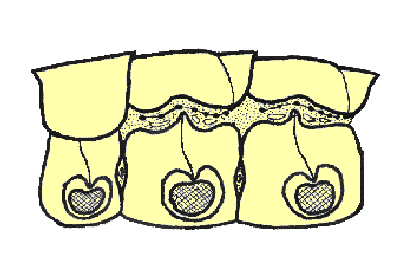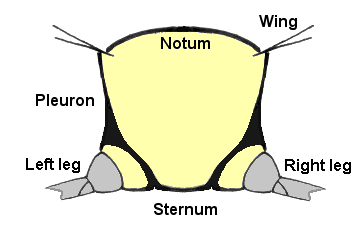
The second (middle) tagma of an insect’s body is called the thorax. This region is almost exclusively adapted for locomotion — it contains three pairs of walking legs and, in many adult insects, one or two pairs of wings.
Structurally, the thorax is composed of three body segments: prothorax, mesothorax, and metathorax. These segments are joined together rigidly to form a “box” that houses the musculature for the legs and wings. Each segment has a dorsal sclerite, the notum (pronotum, mesonotum, and metanotum) which may be further subdivided into an anterior scutum and a posterior scutellum. The ventral sclerite of each segment is the sternum (prosternum, mesosternum, and metasternum).The side of each segment is called the pleuron — it is usually divided by a pleural suture into at least two sclerites:; an anterior episternum and a posterior epimeron.
 The pleural suture marks the location of an internal ridge of exoskeleton (an apodeme) that strengthens the sides of the thorax. Ventrally, this apodeme forms a point of articulation with the basal leg segment (the coxa). In thoracic segments that bear wings, the pleural apodeme runs dorsally into the pleural wing process, a finger-like sclerite that serves as a pivot or fulcrum for the base of the wing.
The pleural suture marks the location of an internal ridge of exoskeleton (an apodeme) that strengthens the sides of the thorax. Ventrally, this apodeme forms a point of articulation with the basal leg segment (the coxa). In thoracic segments that bear wings, the pleural apodeme runs dorsally into the pleural wing process, a finger-like sclerite that serves as a pivot or fulcrum for the base of the wing.
A special “strut” of exoskeleton reinforces the ventral corners of each thoracic segment and provides a rigid site for attachment of leg muscles and ventral longitudinal muscles.This structure, called the furca, forms during development when a pair of sternal apophyses fuse internally with the ridge (apodeme) from each pleural suture. The points of invagination are often visible externally as furcal pits located near the midline of the sternum (and often joined by a sternacostal suture). This internal “brace” mechanism is similar in structure to the tentorium which serves a related function inside the head capsule.

